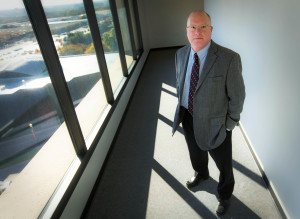A career path focused on reducing alcohol- and drug-related harms
November 24, 2015 • 2015

The year was 1986 when news stunned the country with reports that first-team, all American college basketball player Len Bias had died of a cocaine/alcohol overdose on the University of Maryland campus.
The young athlete – described by some sportswriters as one of the greatest college players ever – had just been drafted by the Boston Celtics two days before.
Ten days later, another prominent athlete, 23-year-old Don Rogers of the NFL’s Cleveland Browns, was tragically reported dead from cocaine induced cardiac arrest on the night before his wedding. Rogers had been named the NFL’s 1984 AFC defensive rookie of the year.
UNTHSC School of Public Health Interim Dean Dennis Thombs, PhD, was a Maryland doctoral student at the time, and as a Residence Life official, oversaw the cluster of residence halls where Bias had overdosed. Impact on the school was devastating, and Thombs remembers the era as a significant turning point for change.
“Our culture was in a very different place in the 80s,” he said. “College-age drinking was widespread, and the country was at the height of recreational drug use. This is when we began hearing about Quaaludes, heroin, cocaine, PCP. We saw the introduction of First Lady Nancy Reagan’s ‘just say no campaign,’ and American opinion polls ranked the crack cocaine epidemic as one of the nation’s biggest concerns.”
In the field of public health, it’s often a series of events that lead a person down a particular career path. With degrees in sociology and mental health counseling and a keen awareness of college challenges through his work at other universities, including Bowling Green State and the University of South Florida, Thombs found his doctoral interests taking him more and more toward advanced study in substance abuse and addictive behaviors.
“Public health is a field of discovery,” he said. “Many of us find our way into public health, rather than specifically choosing the profession; it’s different from deciding to be a physician or a fireman or lawyer at a young age. There’s often a critical turning point we take to address a problem we want to help solve.”
Today, Thombs continues to work on research and solutions, and is recognized for his widely adopted textbook on addictive behavior, now in its 4th edition. In recent years, he made international news for his studies on the effects of alcohol mixed with energy drinks. He has also led research teams in extensive studies of the risks associated with late night drinking in bars and nightclubs catering to young adults. In the last 15 years, his research teams have conducted more than 25,000 face-to-face interviews with intoxicated bar and nightclub patrons late at night.
“Approximately 50 percent of American families are impacted by drug or alcohol addiction, through a first or second degree relative,” he said. “Not all individuals receive care or even recognize they need treatment. We see the results of addiction in the criminal justice system, the health care system and the toll on so many lives. Fortunately, many organizations both locally and nationally continue working to address these problems.”

Social media